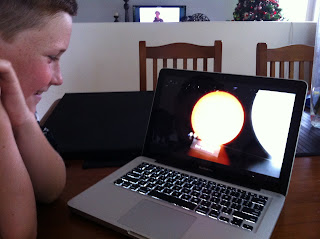Planet Information
When discovering information about the Solar System, I found this great graph explaining the planets' Astronomical Units (AU) distances from the Sun.
After completing my model, I have put all of my research into a booklet. Here are some photos of organising my research. Mum took photos of me writing my rough copy, and typing out my project. I also got to make my booklet with the binder!
I have copied all of my research from my booklet into my blog...check it out!
Mercury
Mercury is the closest planet to the Sun, with a distance of 58 million kilometres from the Sun. Mercury only takes 88 days to orbit the Sun. All planets are named after Roman Gods and Mercury is named after the messenger of Roman Gods. Mercury takes 59 days to spin on its access, experiencing day and night. During the day, on Mercury, it is 400 degrees and at night it is 200 degrees. Unlike Earth, Mercury has no moons and it is the smallest planet. There is no life on Mercury because there is no water and extreme heat.
VENUS
The planet Venus is very bright, it is known as the Evening Star or the Morning Star. Venus takes 262 days to orbit the Sun, so it is faster then Earth. Venus is almost as big as Earth. Venus might not be the closest planet to the Sun, but it is the hottest planet, reaching up to 460 degrees in the day. Venus has no atmosphere, so it is affected by Global Warming. Venus is named after the Roman God of beauty and love. Similar to Mercury, Venus has no moons or water and when there is no water, there is no life.
EARTH
Earth is the only planet with life and liquid water. Our atmosphere has oxygen which is different to all the other planets. Earth’s surface is very fragile because the tectonic plates can create earthquakes. It actually takes Earth 365 1/4 days to orbit the Sun, and it takes 24 hours to rotate. Earth is the only planet inside the asteroid belt to have a moon. Earth isn’t a perfect sphere and it is located in the Goldilocks Zone. The Goldilocks Zone is an area around the Sun, where temperatures are not too hot and not too cold. Earth and Mars are the only planets that are in the Goldilocks Zone.

MARS
Mars is also known as the Red Planet. Like Earth, Mars is located in Goldilocks Zone. It has a North pole and a South pole with frozen water. Mars takes 320 days to orbit the Sun and it is much smaller than Earth. Mars has no Ozone Layer like Earth, so it can get very cold at night and very hot during the day. Mars has lots of dust storms. Mars is the last of the inner planets.
JUPITER
Jupiter is the first of the outer planets and is 300 hundred times bigger than Earth. Jupiter is 777 million kilometres from the Sun. Jupiter is named after a Roman Sky God. It takes 4343 days to orbit the Sun, and 10 hours for 1 day and night. Jupiter spins so fast that it creates lots of storms. Jupiter also has 64 moons and they’re all named. Jupiter actually has 1 ring.
SATURN
Scientists believe that Saturn's rings are made of ice. Saturn has 18 moons, and 1 moon is bigger than Earth. Saturn has an atmosphere and it’s made of gases. It takes 29 1/2 years to orbit the Sun. Saturn is 10 Astronomical Units from the Sun. Saturn takes 10 hours to rotate on its axis. There is a constant whirl storm in the south pole of Saturn. Saturn is known as a gas giant.
URANUS
Uranus was discovered in 1781 by William Herschel. Uranus has 27 moons and it is also known as a gas giant. Uranus is the smallest of the gas giants (outer planets)and it takes 84 years to orbit the Sun. Uranus takes 18 hours to rotate. Uranus is the opposite from Earth because its core is frozen, so that’s why the planet looks blue-green. Uranus has 13 faint rings. Uranus is 19.2 AUs from the Sun.
NEPTUNE
Neptune was discovered in 1875. It was named after the Roman God of Sea. The black dot on Neptune is actually a massive storm. Neptune has 13 moons, and takes 19 hours to rotate around it’s axis. Neptune takes 165 years to orbit the Sun.


















































